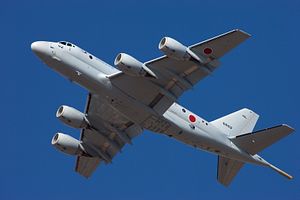Japan will offer Great Britain its first indigenously developed and built maritime patrol aircraft, the Kawasaki P-1, and will send two jets overseas for the first time to participate in UK’s Royal International Air Tattoo – the world’s largest military airshow – according to media reports.
The Japan Maritime Self Defense Force (JMSDF) will dispatch two P-1s, part of the JMSDF’s 51 Air Development Squadron, from the Naval Air Facility Atsugi in Kanagawa Prefecture on July 10, according to the Japanese Ministry of Defense. One aircraft will be on static display, whereas the second plane will perform a flight demonstration at the airshow from July 17-19.
The planes will then head to an airbase near Ambouli International Airport in Djibouti to perform tests and permit “the technical challenges when operating in tropical and desert areas,” according to Japan’s Ministry of Defense quoted by IHS Jane’s Defense Weekly. The JMSDF airbase in Djibouti houses around 200 personnel and two Kawasaki-Lockheed P-3C Orion maritime patrol aircraft – the P-1s predecessor – stationed in Africa in order to conduct anti-piracy operations in the region.
Japan will face fierce competition from the United States with its new Boeing P-8A Poseidon sub-hunting jet. In October 2010, the United Kingdom announced that it would scrap plans to develop and produce a new maritime patrol aircraft of its own, the Nimrod MRA.4. Additionally, the UK government announced that it would decommission its fleet of Nimrod MR.2 leaving the Royal Navy without a fixed wing maritime patrol capability.
The P-1 will gradually replace the JMSDF’s aging fleet of 80 P-3C Orion aircraft. The JMSDF plans to acquire 65 P-1 planes at a rate of one or two per year. However, Japan’s 2015 defense budget allocated 350.4 billion Japanese Yen (USD $ 2.9 billion) for a bulk order of twenty planes in order to reduce unit costs.
First introduced in the JMSDF in March 2013 for “an operational test period” of two years, the P-1 is a four-engined jet powered aircraft with a range of 8,000 km (4,970 miles) and a maximum speed of 996 km/h (619 mph). In order to detect and track submarines as well as smaller surface vessels, the jet is equipped with cutting-edge acoustics and radar technology.
“The sensor suite integrates HPS-106 Active Electronically Scanned Array (AESA), magnetic anomaly detection (MAD) system and Infrared/Light detection systems. The MAD system ensures the detection of submarines by finding magnetic variances made by a submarine in the Earth’s magnetic field,” naval-technology.com explains.
Weapon systems of the P-1 include anti-ship missiles, air-to-surface missiles, torpedoes, mines, depth charges as well as bombs. “The aircraft can also deploy sonobuoys while conducting anti-submarine warfare missions,” naval-technology.com additionally notes.
































